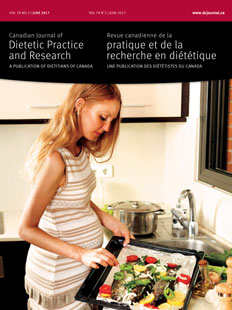Abstract
Purpose: We aimed to describe adherence to gestational weight gain (GWG) recommendations and identify determinants of excessive GWG in a sample of women from Quebec, Canada.
Methods: Data were collected from the multi-centre 3D (Design, Develop, Discover) pregnancy cohort study, which included women who delivered between May 2010 and August 2012 at 9 obstetrical hospitals in Quebec, Canada. GWG was calculated for 1145 women and compared to the 2009 Institute of Medicine (IOM) recommendations.
Results: Overall, 51% of participants exceeded the recommendations. Approximately 68% of women with obesity gained weight in excess of the IOM recommendations. The corresponding numbers were 75%, 44%, and 27% in overweight, normal weight, and underweight women, respectively. A prepregnancy BMI of 25 kg/m2 or more was the only significant predictor of exceeding GWG recommendations (OR 3.35, 95% CI 2.44–4.64) in a multivariate model. Birth weight was positively associated with GWG. GWG and prepregnancy BMI could explain 3.13% and 2.46% of the variance in birth weight, respectively.
Conclusion: About half of women exceeded GWG recommendations, and this was correlated with infant birth weight. This reinforces the need to develop and evaluate strategies, including nutritional interventions, for pregnant women to achieve optimal GWG.
Résumé
Objectif : Notre objectif était de décrire l’adhésion aux recommandations relatives au gain de poids gestationnel (GPG) et d’identifier les déterminants d’un GPG excessif dans un échantillon de femmes du Québec (Canada).
Méthodes : Les données ont été recueillies au sein de l’étude multicentrique 3D (Découvrir, Développer, Devenir), une étude de cohorte de grossesses qui incluait des femmes ayant accouché entre mai 2010 et août 2012 dans neuf hôpitaux obstétriques du Québec. Le GPG a été calculé pour 1 145 femmes et comparé aux recommandations de 2009 de l’Institute of Medicine (IOM).
Résultats : Dans l’ensemble, 51 % des participantes ont dépassé les recommandations. Environ 68 % des femmes obèses ont pris du poids au-delà des recommandations de l’IOM. Les chiffres correspondants étaient de 75 %, 44 % et 27 % pour les femmes en excès de poids, ayant un poids normal et en insuffisance pondérale, respectivement. Un IMC prégrossesse de 25 kg/m2 ou plus était le seul prédicteur significatif du dépassement du GPG recommandé (RC 3,35, IC à 95 %, 2,44–4,64) dans un modèle multivarié. Le poids de naissance était positivement associé au GPG. Le GPG et l’IMC prégrossesse pourraient expliquer 3,13 % et 2,46 % de la variance dans le poids de naissance, respectivement.
Conclusions : Environ la moitié des femmes ont dépassé les recommandations de GPG, ce qui était associé avec le poids de naissance du nouveau-né. Ces résultats renforcent la nécessité d’élaborer et d’évaluer des stratégies, notamment des interventions en nutrition, pour les femmes enceintes afin d’atteindre à un GPG optimal.



